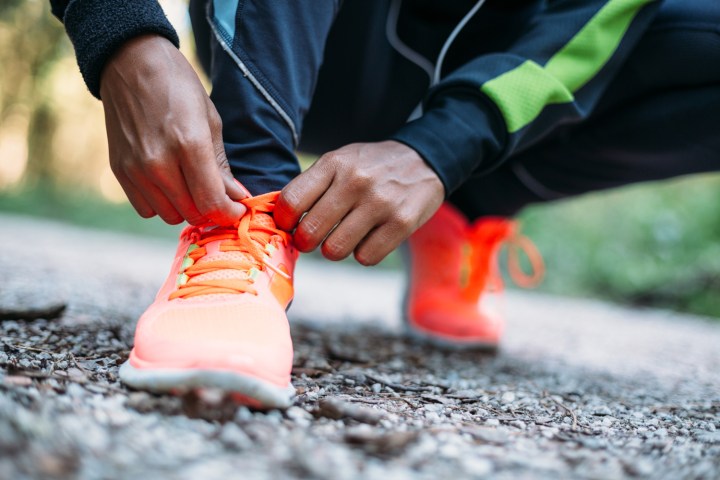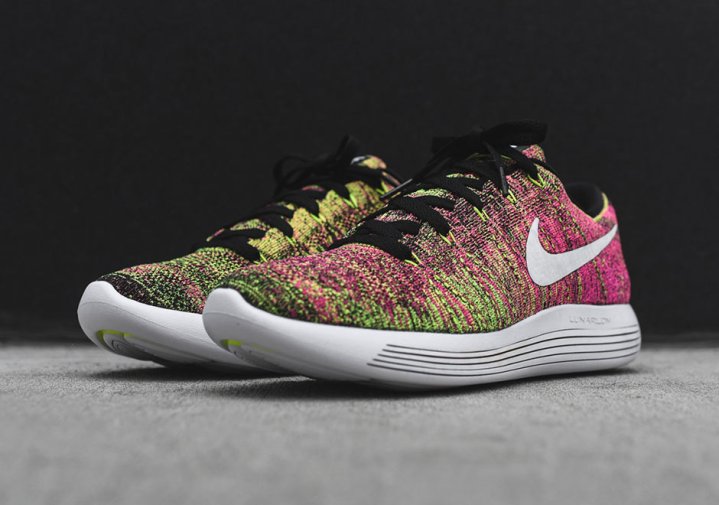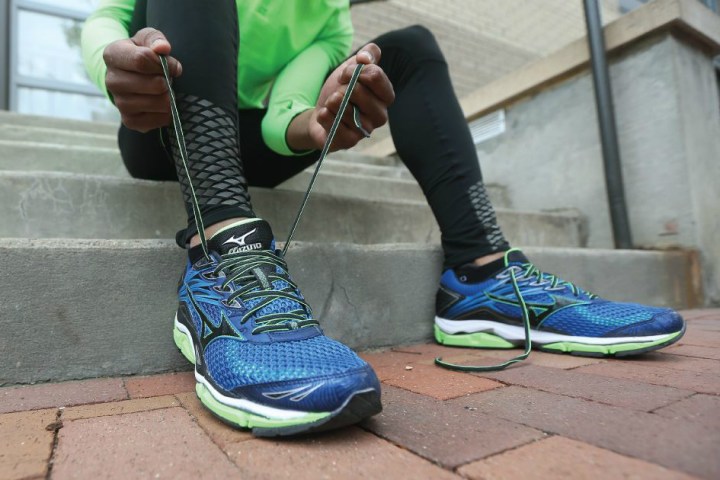
Innovations in athletic footwear have been regular occurrences since the 1970s, when Nike co-founder Bill Bowerman accidentally created the “Waffle Trainer,” thus revolutionizing the track-and-field landscape — and making Nike an ocean of cash in the process. These days, pricey running shoes from top brands are built using several different technologies to maximize comfort and durability.
If you’re wondering what all these technologies actually do, you’re not alone. In the interest of making informed purchases, we’ve compiled a handy guide (organized by brand) explaining how these technologies work and what the peculiar names actually mean.
Glossary
When searching for the right pair of runners, you might come across some unfamiliar vocabulary. To aid your quest, we’ve put together a short glossary of related terminology with which you may or may not be familiar. Some of these terms might be included in descriptions of brand-specific technologies below.
- EVA: A light, flexible copolymer or cross-linked foam composed of ethylene (E) and vinyl acetate (VA). Made up of lots of minuscule cells filled with air, EVA compresses when weight is placed upon it; over time, it doesn’t decompress as effectively.
- PU: Polyurethane. Similar to EVA but heavier and denser, resulting in less natural compression. Generally more durable than EVA and it lasts longer before wearing down.
- Collar: The part of the shoe that surrounds your upper heel.
- Crash zone: The area of your foot that strikes the ground first, absorbing the most impact.
- Drop: The height difference from heel to toe. Usually measured in millimeters.
- Footstrike: The moment (while running or walking) when the entire foot lays flat on the ground.
- Forefoot: The front section of the bottom of your foot. Also sometimes called the “ball” of the foot.
- Gait: A person’s style of walking or running.
- Lugs: Rubber treads on the outsole, generally meant to improve traction.
- Midsole: The cushioned layer between the upper and outsole. Usually made of foam.
- Outsole: The bottom layer of a shoe, designed to come in contact with the ground or floor. Usually made of rubber or carbon.
- Pronation: The foot’s natural roll following a footstrike. Overpronation occurs when the foot rolls excessively inward.
- Toe box: The front of the shoe, housing the toes.
- Treads: The part of the outsole that comes directly into contact with the ground or floor.
- Upper: The part of the shoe that wraps around the foot. Usually a combination of materials.
Nike

Flyknit: A lightweight, form-fitting polyester yarn shoe upper, designed to reduce material waste by eliminating the need for multiple panels. Flywire cables vary in length and placement, depending upon location. Flyknit shoes hug the ankle and are designed to be comfortable with or without socks
Air-Sole: Pressurized bags of air, wrapped in rubber, to improve cushioning and durability (relative to EVA foam).
VaporMax: Air soles are connected directly to the shoe’s upper, so there’s no “midsole” or “outsole,” only an air sole. Improves flexibility and spring.
Lunarlon: A combination of soft and firm foam cushioning to absorb impact and improve heel-to-toe impact transition.
Hyperfuse: Three material layers — a synthetic base, a mesh center, and a TPU (thermoplastic polyurethane) film top layer — fused together using a hot-melt process to combine durability with breathability.
Zoom: Thin, lightweight cushioning under the heel and forefoot. Provides impact absorption with minimal weight.
Free: Nike Free shoes are designed to replicate the benefits of barefoot exercise while still providing comfort and protection. Deep siping and reverse flex grooves on the outsole encourage flexion and extension in all directions.
Max Air: Small air-filled bags replace parts of the midsole to reduce weight and provide improved impact response.
Shox: Hollowed-out columns, atop a PEBAX dispersion plate, that collapse toward the center of the heel to control impact and propel the foot forward. These are rarely used anymore.
Nike Dynamic Support: Strengthened midsole with soft foam on the lateral side, and firm foam on the medial side, to improve smoothness.
Adidas
Adaptive Traxion: Continental rubber outsole built to improve grip and propulsion on irregular running surfaces, including wet environs.
Boost: A foam cushioning technology designed to return maximum energy. Softer than regular EVA, but with impact response like PU.
Bounce: Soft foam midsole designed to provide maximum elasticity. Adidas redesigned the Bounce tech before releasing the AlphaBounce line of performance running sneakers.
Climachill: Fabric woven with titanium and 3D aluminum cooling spheres to provide an instant chilling sensation and improve performance in warm conditions.
Fitcounter: A molded heel counter built to allow optimal Achilles movement.
Forged Mesh: Single-layer shoe upper with a ribbed pattern — designed to fit snugly, allowing maximum flexibility and free foot movement, while simultaneously providing ankle support. Created using ARAMIS motion capture technology, which helps determine the amount of strain put on each individual part of the foot.
Primeknit: A one-piece digital knit upper, with heat fusion applied to high-tension areas. Provides superior durability, elasticity, and comfort when compared to standard knit.
Quickstrike: Light synthetic outsole molded directly onto a thin textile base, providing abrasion resistance to improve durability and reduce weight.
Stableframe: Modified midsole built to house the foot, rather than sit below it. Improves support and guides the foot safely through its stride.
Stretchweb: A rubber compound outsole designed to reduce pressure created via footstrikes, therefore reducing impact and risk of injury.
Torsion System: A thermoplastic arch support, designed to allow independent movement of both forefoot and rearfoot without increasing strain; improves heel-to-toe impact transition.
Ultraboost: An improved version of the Adidas Boost tech, featuring TPU “energy capsules” within the midsole to improve impact response. In comparison to regular EVA, Ultraboost maintains performance at high and low temperatures and is more durable.
New Balance

EnCap: A core of soft cushioning EVA in the midsole, with a tough polyurethane rim for more support and durability.
Fresh Foam: A foam midsole composed of three separate materials; more resistant and responsive than RevLite. Reduced drop from heel to toe.
REVlite: An innovative foam compound providing the same responsiveness and durability of New Balance foams that are 30 percent heavier. REVlite offers a lightweight ride without minimizing construction or sacrificing underfoot cushioning or stability.
Mizuno

Cloudwave: Update of Mizuno’s Wave technology, which manifested in uniquely shaped midsoles built to evenly disperse energy and correct overpronation. Cloudwave utilizes convex technology to provide a softer and smoother feel. Available in multiple shapes to accommodate different types of feet.
DynamotionFit: An upper constructed with Mizuno Flex eyelets and stretch mesh. Built to move with the foot instead of restricting movement.
Intercool: Full-length midsole ventilation to reduce heat and humidity within the shoe.
U4icX Midsole: Blend of EVA and PU to combine comfort and responsiveness with durability.
SmoothRide Engineering: Flex Grooves and Controllers in the heel and forefoot work together to promote natural movement via a rocking-chair motion from the heel to the toes.
Reebok

Floatride: Soft foam midsole that maximizes cushioning without sacrificing impact response.
PUMP: Reebok running shoes equipped with PUMP technology are completely structure-less until inflated, at which point the stretch-fit bladder molds to the shape of your foot for a seamless fit.
Smoothfuse: Synthetic, lightweight, seamless mesh upper that mimics knit uppers at reduced cost.
Ultraknit: Seamless knit upper that provides breathability and flexibility. Similar to Primeknit from Adidas.
Asics

ComforDry: A label applied to different parts of the shoe; ComforDry materials wick moisture and provide breathability.
Duomax: A unique sole structure, built at an angle to combat stress due to overpronation.
FluidAxis: Irregular grooves cut into the outsole heel, designed to allow natural foot flexion and improve comfort.
Fluidfit: A mesh upper consisting of an elastic section and a reinforced section, designed to improve responsiveness and stability while running.
Fluidride: Twin-layer midsole constructed of lightweight Solyte and springy SpEVA to provide shock absorption without increasing shoe weight
Flytefoam: Organic fiber foam midsole that improves impact response relative to low-impact foams like EVA
Trusstic: A resin inlaid in the outsole, providing stability by preventing the shoe from twisting in an unnatural manner. The pattern of the resin is dependent upon the type of shoe.
Brooks

3D Fit Print: A process that utilizes screen-printing technology to apply engineered structure to the upper section of shoes. Using this process reduces weight and improves flexibility while maintaining structural integrity.
3D Hex Lugs: Grippy lugs on the outsole, designed to provide maximum grip on irregular running surfaces.
Ballistic Rock Shield: A thermoplastic EVA sheath, located between the midsole and outsole, built to protect the forefoot by spreading out impact loads from sharp trail objects like rocks and sticks.
BioMoGo: A biodegradable midsole. Traditional EVA midsoles last up to 1,000 years in a landfill; BioMoGo midsoles biodegrade in approximately 20 years in the same environment.
DNA Midsole and SuperDNA: A cushioned midsole that responds to stress by dispersing pressure and providing resiliency in necessary locations. This unique technology responds to the shape of your foot and your gait to improve impact response and comfort.
Guide Rails: Structure built into the midsole to help runners stay on balance, without shifting weight too far to either side. Designed to encourage the body’s natural running motion.
Ideal Pressure Zones: Segmented sole design built to evenly distribute strike impact across the foot. Reduces discomfort and improves stride smoothness.
Segmented Crash Pad: A midsole made up of independent shock absorbers built to improve comfort and heel-to-toe impact transition performance.



